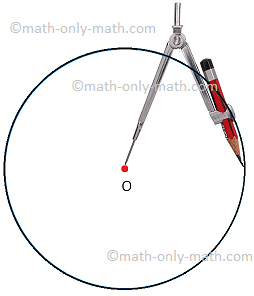Amplitude or Argument of a Complex Number
To find the Amplitude or Argument of a complex number let us assume that, a complex number z = x + iy where x > 0 and y > 0 are real, i = √-1 and x\(^{2}\) + y\(^{2}\) ≠ 0; for which the equations x = |z| cos θ and y = |z| sin θ are simultaneously satisfied then, the value of θ is called the Argument (Agr) of z or Amplitude (Amp) of z.
From the above equations x = |z| cos θ and y = |z| sin θ satisfies infinite values of θ and for any infinite values of θ is the value of Arg z. Thus, for any unique value of θ that lies in the interval - π < θ ≤ π and satisfies the above equations x = |z| cos θ and y = |z| sin θ is known as the principal value of Arg z or Amp z and it is denoted as arg z or amp z.
We know that, cos (2nπ + θ) = cos θ and sin (2nπ + θ) = sin θ (where n = 0, ±1, ±2, ±3, .............), then we get,
Amp z = 2nπ + amp z where - π < amp z ≤ π
Algorithm for finding
Argument of z = x + iy
Step I: Find the value of tan\(^{-1}\) |\(\frac{y}{x}\)| lying between 0 and \(\frac{π}{2}\). Let it be α.
Step II: Determine in which quadrant the point M(x, y) belongs.
If M (x, y) belongs to the first quadrant, then arg (z) = α.
If M (x, y) belongs to the second quadrant, then arg (z) = π - α.
If M (x, y) belongs to the third quadrant, then arg (z) = - (π - α) or π + α
If M (x, y) belongs to the fourth quadrant, then arg (z) = -α or 2π - α
Solved Examples to find the Argument or Amplitude of a complex number:
1. Find the argument of the complex number \(\frac{i}{1 - i}\).
Solution:
The given complex number \(\frac{i}{1 - i}\)
Now multiply the numerator and denominator by the conjugate of the denominator i.e., (1 + i), we get
\(\frac{i(1 + i)}{(1 - i)(1 + i)}\)
= \(\frac{i + i^{2})}{(1 - i^{2}}\)
= \(\frac{i - 1}{2}\)
= - \(\frac{1}{2}\) + i ∙ \(\frac{1}{2}\)
We see that in the z-plane the point z = - \(\frac{1}{2}\) + i ∙ \(\frac{1}{2}\) = (-\(\frac{1}{2}\), \(\frac{1}{2}\)) lies in the second quadrant. Hence, if amp z = θ then,
tan θ = \(\frac{\frac{1}{2} }{- \frac{1}{2}}\) = -1, where \(\frac{π}{2}\) < θ ≤ π
Thus, tan θ = -1 = tan (π- \(\frac{π}{4}\)) = tan \(\frac{3π}{4}\)
Therefore, required argument of \(\frac{i}{1 - i}\) is \(\frac{3π}{4}\).
2. Find the argument of the complex number 2 + 2√3i.
Solution:
The given complex number 2 + 2√3i
We see that in the z-plane the point z = 2 + 2√3i = (2, 2√3) lies in the first quadrant. Hence, if amp z = θ then,
tan θ = \(\frac{2√3 }{2}\) = √3, where θ lying between 0 and \(\frac{π}{2}\).
Thus, tan θ = √3 = tan \(\frac{π}{3}\)
Therefore, required argument of 2 + 2√3i is \(\frac{π}{3}\).
11 and 12 Grade Math
From Amplitude or Argument of a Complex Number to HOME PAGE
Didn't find what you were looking for? Or want to know more information about Math Only Math. Use this Google Search to find what you need.
Recent Articles
-
Dividing 3-Digit by 1-Digit Number | Long Division |Worksheet Answer
Apr 24, 24 03:46 PM
Dividing 3-Digit by 1-Digit Numbers are discussed here step-by-step. How to divide 3-digit numbers by single-digit numbers? Let us follow the examples to learn to divide 3-digit number by one-digit nu… -
Symmetrical Shapes | One, Two, Three, Four & Many-line Symmetry
Apr 24, 24 03:45 PM
Symmetrical shapes are discussed here in this topic. Any object or shape which can be cut in two equal halves in such a way that both the parts are exactly the same is called symmetrical. The line whi… -
Mental Math on Geometrical Shapes | Geometry Worksheets| Answer
Apr 24, 24 03:35 PM
In mental math on geometrical shapes we will solve different type of problems on simple closed curves, polygons, basic geometrical concepts, perpendicular lines, parallel lines, circle, terms relates… -
Circle Math | Terms Related to the Circle | Symbol of Circle O | Math
Apr 24, 24 02:57 PM
In circle math the terms related to the circle are discussed here. A circle is such a closed curve whose every point is equidistant from a fixed point called its centre. The symbol of circle is O. We… -
Fundamental Geometrical Concepts | Point | Line | Properties of Lines
Apr 24, 24 12:38 PM
The fundamental geometrical concepts depend on three basic concepts — point, line and plane. The terms cannot be precisely defined. However, the meanings of these terms are explained through examples.




